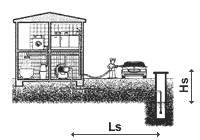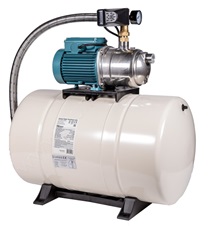A detailed description of what we need to know before we start selecting a pressure booster pump and what data we need to obtain.
Where do we want to pump water from
Another thing we need to know is where we want to pump water from. Whether it is river or pond water, a borehole or a well, how deep the water is and how far the water source is.
- Surface pumps can only draw water from a depth of 8m. From greater depths, we must use a submersible pump. From a technical point of view, therefore, the water source is decisive. If the height between the intake and the water level is less than 8m, including losses in the horizontal part of the intake manifold, we choose a water plant with a pump on the surface, otherwise a water plant with a pump in a well or borehole. A submersible pump can almost always be used. It is more expensive, but it has certain advantages.
- The height difference in water is one of the variables important for calculating pump power. We have to add all heights from the water source to the outlet and add the loss of 1 m in height for every 10 m of pipe length. At the same time, it is necessary to be able to convert to meters another quantity: 10 m height corresponds to 1 Atm, 100 J/kg, 0,1 Mpa.
- To determine the required water pressure (MPa) at the place of consumption, it is necessary to know the location and types of appliances: automatic washing machine, dishwasher, etc.
- If we want to pump water from a river or stream, the distance of our land from the water source can be a decisive factor, because the technical parameters of the pump do not have to play the most important role here, but security against theft. In this case, it is better to use the surface pump on your own plot than submersible at the water source.

(Hs) level (from pump neck to lowest water level)
(Ls) distance of the well from the intended location of the waterworks
How often do we want to pump it
Do you need a pump for occasional use e.g. in the garden or permanently in a family house? Possibly deployed 24 hours a day?
- Plastic pumps are recommended for occasional use. Stainless steel pumps are recommended for permanent use.
- If we want to supply the property with water, we must use domestic waterworks.
- Part of the domestic waterworks is a pressure vessel, nowadays mostly membrane, which prevents frequent switching of the pump.
- Compact automatic machines (no need to purchase pressure vessels, pressure switch and other components) will be used in areas with a lack of space. The advantage of compact water plants is automatic operation - the pump starts only when water is consumed.
- The output of the domestic waterworks is always determined by the output of the pump and not by the size of the vessel, which affects the frequency of switching the pump.
- The size of the container can therefore be derived from the water consumption data - it is advisable to leave the overall assembly to the expert.
How to avoid pressure fluctuations?
Domestic water plants with a frequency inverter that permanently senses the pressure in the system and changes the pump speed depending on the current water flow are suitable for objects with variable water consumption but the need to maintain a constant pressure.
How much do we want to pump
Another important indicator for the purchase of the pump is the amount of water (flow) that we want to pump, marked with the letter Q, the units arel/s, l/min., m³/h. There are two indicators for determining the amount of water, the number of people and the spectrum of water use. In particular, the second indicator is currently important for swimming pools, saunas, dishwashers and large gardens.
For this reason, the demand for immediate consumption of water has increased in the last few years, especially in family houses. For the supply of such a house, a power of about 3m³/hour with sufficient pressure is required.
Pumps up to 2,000 liters per hour should be sufficient for garden watering and similar occasions.

